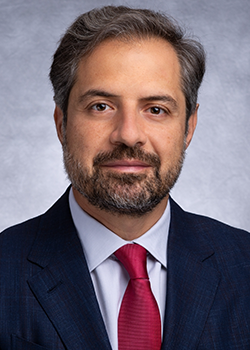Commentary
Article
Improved OS, Cost Effectiveness Are Necessary to Shift Later-Line TKIs to Frontline CML-CP
Author(s):
Elias Jabbour, MD, discusses the potential activity and financial benefit of novel and emerging TKIs for first-line management of chronic phase CML.
Elias Jabbour, MD

For second- and later-line TKIs to be considered viable for earlier use in the treatment of chronic myeloid leukemia-chronic phase (CML-CP), they must demonstrate equivalent or superior overall survival (OS) outcomes and be cost effective when compared with generic imatinib, according to Elias Jabbour, MD.
Although TKIs such as dasatinib (Sprycel), bosutinib (Bosulif), nilotinib (Tasigna), ponatinib (Iclusig), and asciminib (Scemblix) are later-line options for this patient population, hurdles must be cleared to move these agents to the frontline. In his presentation during the 2024 SOHO Annual Meeting, Jabbour noted that a significant proportion of patients with CML-CP can expect to have a normal lifespan.1 Data from The University of Texas MD Anderson Cancer Center in Houston demonstrated that 10-year OS rate has been 95% over the last 10 to 15 years.2
In the frontline setting, the goal is to normalize the OS. “I think we can reach this goal, and survival today is close to the normal population,” Jabbour, who is a professor in the Department of Leukemia, Division of Cancer Medicine, at The University of Texas MD Anderson Cancer Center, said. “However, the second goal would be to stop therapy and induce deep molecular remission [DMR]."
DMR is ideal because there is a lower risk of loss response and resistance due to TKI use. Other goals would be to reduce grade 3 or 4 prohibitive toxicities and to make TKIs available and affordable to 100% of patients.
In a cohort analysis involving six consecutive or parallel prospective clinical trials of TKIs, Sasaki et al.3 conducted univariate and multivariate analyses to investigate factors associated with survival probability. Overall, 483 patients were evaluated: 271 received imatinib, 105 received nilotinib, and 107 received dasatinib.
For the total population, 5-year survival was only slightly lower than that of the matched general population (relative survival 94.8% [95% CI, 92.1%–97.4%]). Individuals of all ages with a report of complete cytogenetic response to treatment within 1 year had a 5-year survival similar to that of the general population.3
A German study explored whether treatment with imatinib at 400 mg/day (n = 400) could be optimized by doubling the dose (n = 420), adding interferon (n = 430) or cytarabine (n = 158), or using imatinib after interferon failure (n = 128).4
Jabbour highlighted the survival data from this study, commenting that “relative survival when compared with the normal population at 10 years is 92%.” True resistance was shown to be 10% over 10 years or 1% per year. “Most patients will do extremely well on imatinib therapy and will not require a change in therapy,” Jabbour said.
Turning to second-generation and later-line agents, Jabbour emphasized that most have been compared with imatinib. The newer agents have demonstrated varying levels of progression-free survival rates, major molecular responses (MMRs), and complete cytogenic responses, Jabbour said, “but none of them have demonstrated an OS benefit.”
Jabbour also noted that the cost of generic imatinib at 400 mg had an average wholesale price (AWP) of $416.00 for 1 year, which roughly translates to $12,500 per 30 years based on the price of generic drugs at cost plus 15% profit. Comparatively, the AWP of dasatinb at 100 mg is $222,000 for 1 year, nilotinib at 300 mg twice a day is $261,000 for 1 year, bosutinib at 400 mg is $244,000 for 1 year, and ponatinib at 45 mg, 30 mg, or 15 mg is $265,000 for 1 year.
“Before generic imatinib was available, treatment-free remission for second-generation TKIs was cost-effective, but that has changed,” Jabbour said. Generic imatinib costs $35/month, $420.00/year, and $12,500 over 30 years.
“For any TKI to have a good treatment value, it has to cost less than $40,000 per year to be cost-effective,” Jabbour said.
Based on these criteria, Jabbour highlighted the conditions under which a new TKI should be considered for front-line CML therapy.5 First, it should be superior to currently available second-generation TKIs. In particular, improving survival rates will be difficult.
Further, long-term safety should be equivalent to or greater than 7 to 8 years. “Current cost-effective generic TKIs cost $500 to $5,000 a year. New TKIs as front-line therapy for CML should cost less than $30,000 to $40,000 per year,” Jabbour concluded.
References
- Jabbour E. Choosing the best first line drug in CML-CP—Does efficacy make you think about cost? Presented at: 12th Annual Meeting of the Society of Hematologic Oncology (SOHO 2024). September 4-7, 2024. Houston, TX.
- Harrison’s Principles of Internal Medicine, 21e: Loscalzo J, Fauci A, Kasper D, Hauser S, Longo D, Jameson J. Eds. Joseph Loscalzo, et al. McGraw-Hill Education, 2022
- Sasaki K, Strom SS, O'Brien S, et al. Relative survival in patients with chronic-phase chronic myeloid leukaemia in the tyrosine-kinase inhibitor era: analysis of patient data from six prospective clinical trials. Lancet Haematol. 2015;2(5):e186-e193. doi:10.1016/S2352-3026(15)00048-4
- Hehlmann R, Lauseker M, Saußele S, et al. Assessment of imatinib as first-line treatment of chronic myeloid leukemia: 10-year survival results of the randomized CML study IV and impact of non-CML determinants. Leukemia. 2017;31(11):2398-2406. doi:10.1038/leu.2017.253
- Kantarjian H, Branford S, Breccia M, et al. Are there new relevant therapeutic endpoints in the modern era of the BCR::ABL1 tyrosine kinase inhibitors in chronic myeloid leukemia?. Leukemia. 2024;38(5):947-950. doi:10.1038/s41375-024-02229-3









